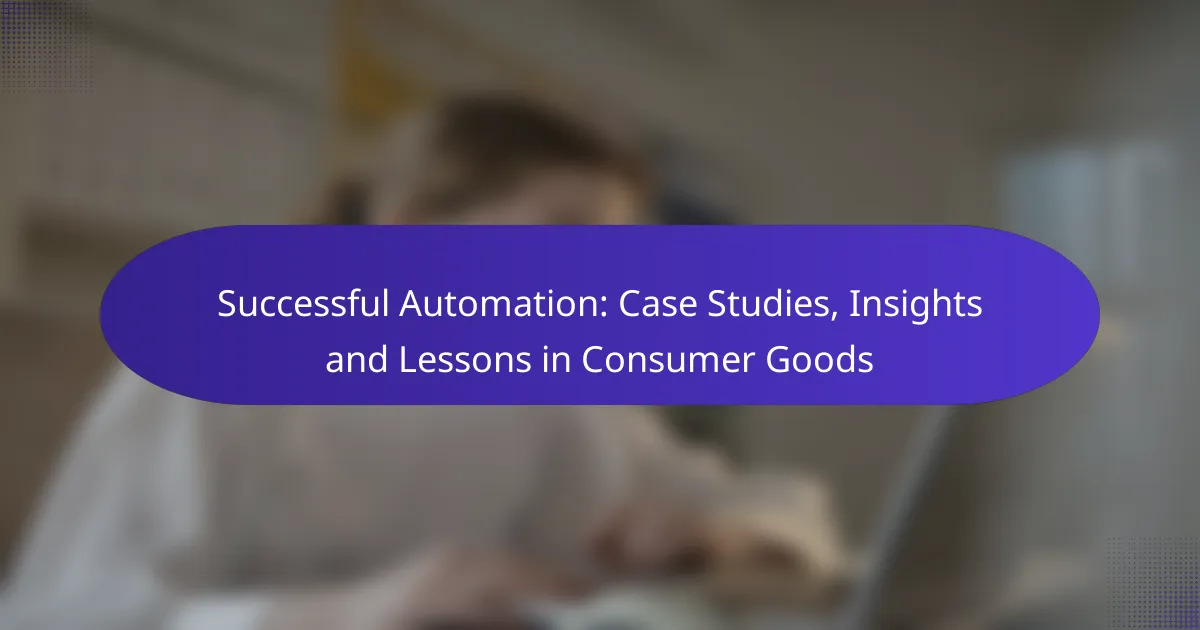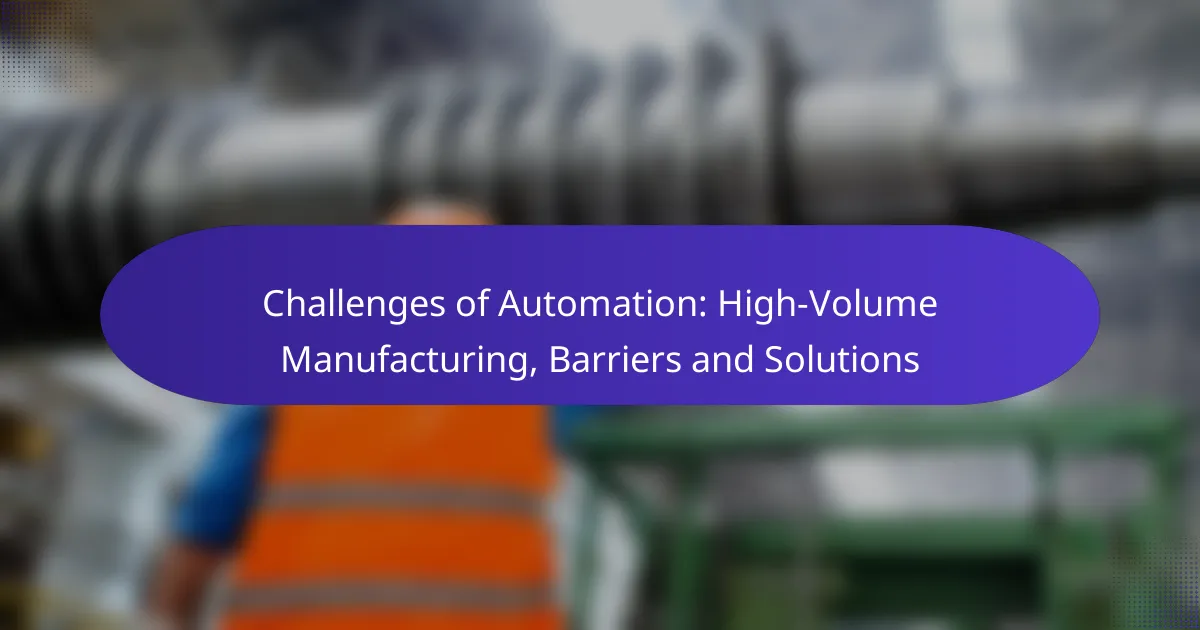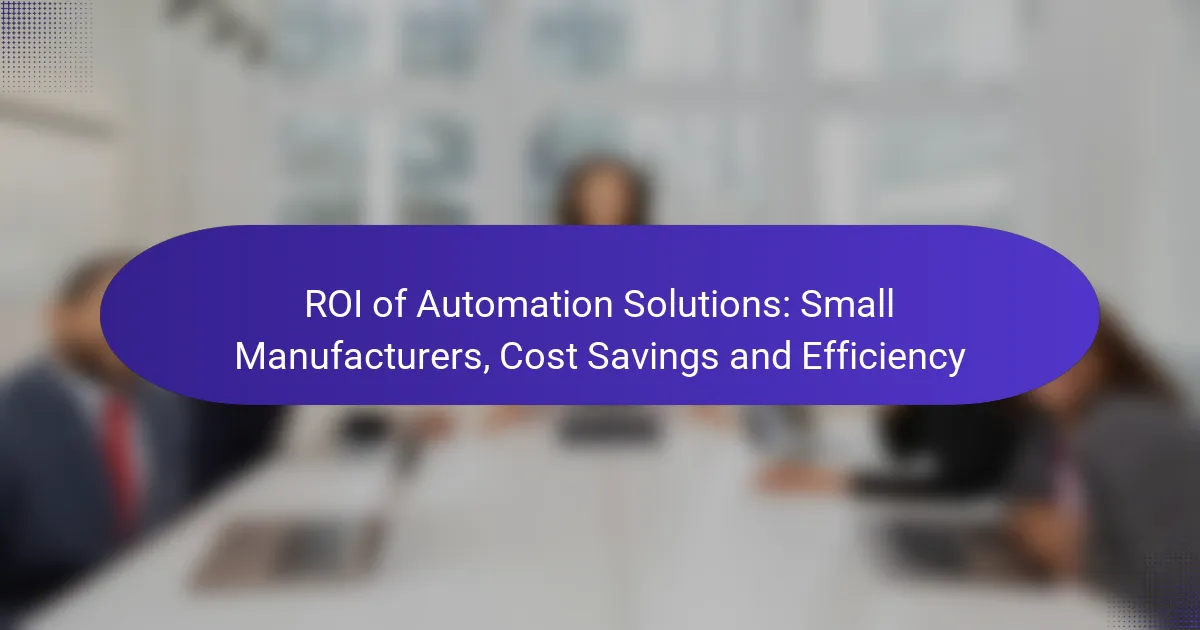In the consumer goods sector, successful automation strategies are pivotal for enhancing efficiency, cutting costs, and boosting customer satisfaction. By leveraging advanced technologies like robotics and artificial intelligence, companies can streamline operations and improve product quality. Case studies highlight essential lessons in effective implementation, emphasizing the importance of employee training and seamless integration with existing systems.

What are successful automation strategies in consumer goods?
Successful automation strategies in consumer goods focus on enhancing efficiency, reducing costs, and improving customer satisfaction. These strategies often involve integrating advanced technologies such as robotics, artificial intelligence, and automated systems to streamline operations and deliver better service.
Robotics in warehouse management
Robotics plays a crucial role in warehouse management by automating tasks such as picking, packing, and sorting. Automated guided vehicles (AGVs) and robotic arms can significantly speed up these processes, reducing labor costs and minimizing human error.
Implementing robotics requires careful planning, including assessing the layout of the warehouse and the types of products handled. Companies should consider starting with pilot projects to evaluate the effectiveness of robotic solutions before full-scale implementation.
AI-driven inventory optimization
AI-driven inventory optimization uses machine learning algorithms to predict demand and manage stock levels efficiently. This approach helps companies maintain optimal inventory, reducing excess stock and minimizing stockouts.
To implement AI-driven inventory systems, businesses should gather historical sales data and analyze market trends. Regularly updating algorithms based on real-time data can enhance accuracy and responsiveness to changing consumer preferences.
Automated customer service solutions
Automated customer service solutions, such as chatbots and virtual assistants, improve response times and enhance customer engagement. These tools can handle common inquiries, allowing human agents to focus on more complex issues.
When deploying automated customer service, it’s essential to ensure seamless integration with existing systems and provide clear escalation paths for unresolved queries. Regularly updating the knowledge base and training the AI on new products can enhance the customer experience.
Smart supply chain management
Smart supply chain management leverages IoT devices and data analytics to enhance visibility and coordination across the supply chain. This approach allows businesses to monitor shipments in real-time and make informed decisions based on data insights.
To achieve smart supply chain management, companies should invest in IoT technology and data analytics platforms. Collaborating with suppliers and logistics partners to share data can lead to improved efficiency and cost savings throughout the supply chain.
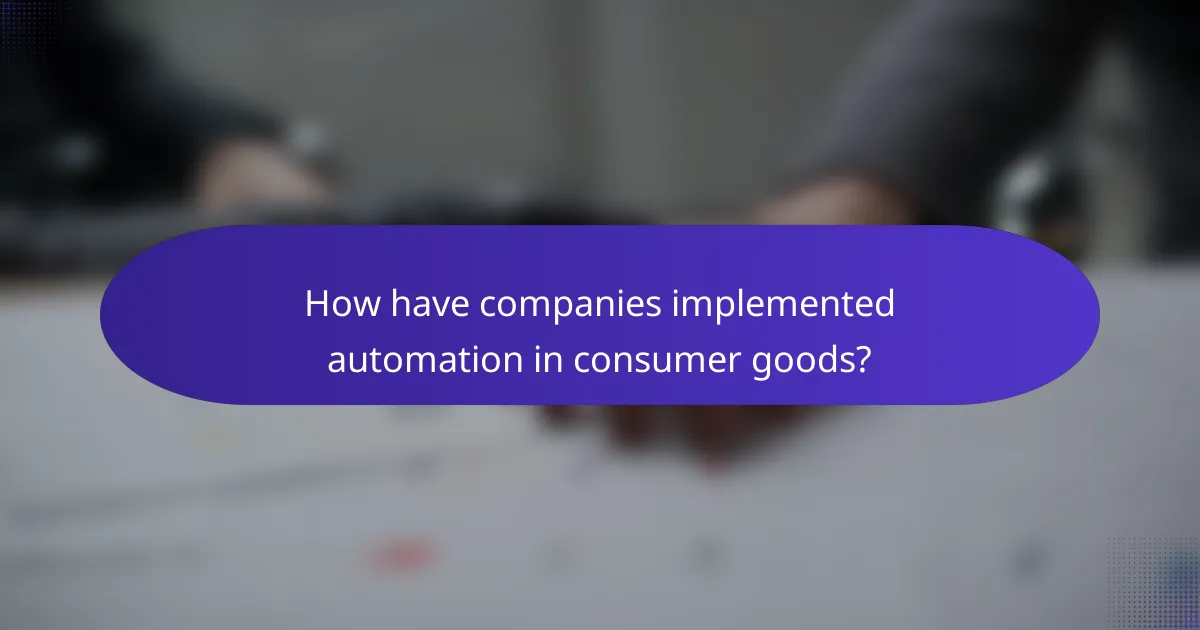
How have companies implemented automation in consumer goods?
Companies in the consumer goods sector have adopted automation to enhance efficiency, reduce costs, and improve product quality. This implementation often involves integrating advanced technologies such as robotics, artificial intelligence, and data analytics into production and supply chain processes.
Procter & Gamble’s automated production lines
Procter & Gamble (P&G) has revolutionized its manufacturing processes through automated production lines that utilize robotics and advanced machinery. These lines are designed to operate with minimal human intervention, allowing for faster production cycles and consistent quality across products.
For instance, P&G’s facilities employ automated systems for tasks such as packaging and quality inspection. This not only speeds up production but also reduces the likelihood of human error, leading to significant cost savings and increased output.
Coca-Cola’s use of AI for demand forecasting
Coca-Cola leverages artificial intelligence to enhance its demand forecasting capabilities, allowing the company to optimize inventory management and production schedules. By analyzing vast amounts of data, including sales trends and consumer behavior, Coca-Cola can predict demand fluctuations more accurately.
This AI-driven approach enables Coca-Cola to adjust its production levels proactively, reducing waste and ensuring that popular products are readily available. Implementing such technology has proven beneficial, particularly in responding to seasonal demand changes and market trends.
Unilever’s robotic process automation
Unilever has embraced robotic process automation (RPA) to streamline various administrative and operational tasks. RPA allows Unilever to automate repetitive processes such as order processing, invoicing, and data entry, freeing up employees to focus on more strategic initiatives.
By employing RPA, Unilever has seen improvements in efficiency and accuracy, with tasks that previously took hours now completed in minutes. This shift not only enhances productivity but also reduces operational costs, making it a valuable strategy in the competitive consumer goods market.
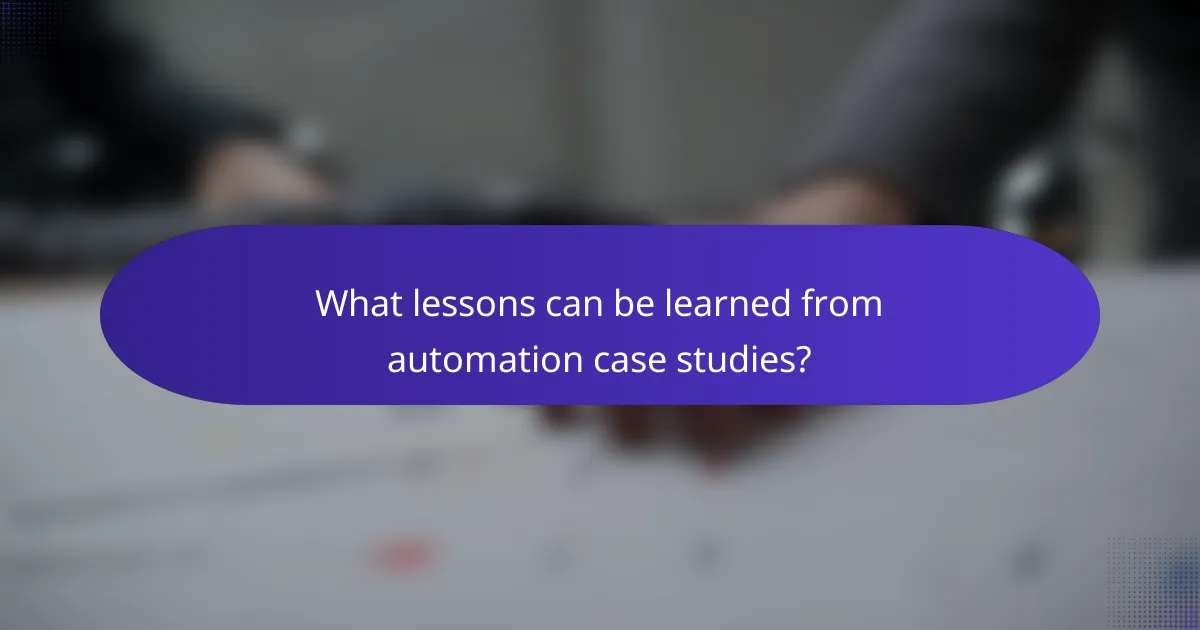
What lessons can be learned from automation case studies?
Automation case studies reveal critical lessons about effective implementation and management of automated systems in consumer goods. Key takeaways include the necessity of employee training, the importance of scalable solutions, and the need for seamless integration with existing systems.
Importance of employee training
Employee training is essential for the successful adoption of automation technologies. Well-trained staff can operate new systems efficiently, reducing errors and increasing productivity. Companies should invest in comprehensive training programs that cover both technical skills and change management.
For instance, a consumer goods manufacturer might implement a new robotic assembly line. Without proper training, employees may struggle to adapt, leading to delays and safety issues. Regular workshops and hands-on sessions can help bridge this gap.
Need for scalable solutions
Scalability is crucial when implementing automation in consumer goods. Solutions should be designed to grow with the business, accommodating increased production demands without significant overhauls. This flexibility can save costs and time in the long run.
For example, a small beverage company may start with a basic automated bottling system. As demand increases, they can expand the system with additional machines or software upgrades, ensuring they meet market needs without starting from scratch.
Integration with existing systems
Successful automation requires seamless integration with current systems and processes. Disparate systems can lead to inefficiencies and data silos, undermining the benefits of automation. A thorough assessment of existing workflows is necessary before implementation.
Consider a retail company that automates its inventory management. If the new system does not integrate well with the point-of-sale software, it could result in inaccurate stock levels and lost sales. Prioritizing compatibility can enhance overall operational efficiency and customer satisfaction.

What are the challenges of automation in consumer goods?
Automation in consumer goods faces several challenges that can hinder its successful implementation. Key issues include high initial investment costs, resistance to change among staff, and data security concerns.
High initial investment costs
One of the primary challenges of automation in the consumer goods sector is the high initial investment required. Companies often need to allocate significant funds for purchasing advanced machinery, software, and training programs. This upfront cost can be a barrier, especially for small to medium-sized enterprises.
To mitigate these costs, businesses can explore financing options or phased implementation strategies. For instance, investing in modular automation solutions allows companies to gradually scale their operations without overwhelming their budgets.
Resistance to change among staff
Resistance to change is a common hurdle when implementing automation in consumer goods. Employees may fear job loss or feel unprepared to adapt to new technologies. This apprehension can lead to decreased morale and productivity.
To address this issue, companies should prioritize communication and training. Engaging staff in the automation process and providing comprehensive training can help alleviate fears and foster a culture of innovation. Regular feedback sessions can also help employees feel valued and involved.
Data security concerns
Data security is a critical concern in the automation of consumer goods, particularly as systems become more interconnected. The risk of cyberattacks increases with the integration of IoT devices and cloud-based solutions, potentially compromising sensitive information.
To protect against these threats, businesses should implement robust cybersecurity measures, including regular software updates, employee training on security protocols, and the use of encryption technologies. Conducting regular security audits can also help identify vulnerabilities before they can be exploited.
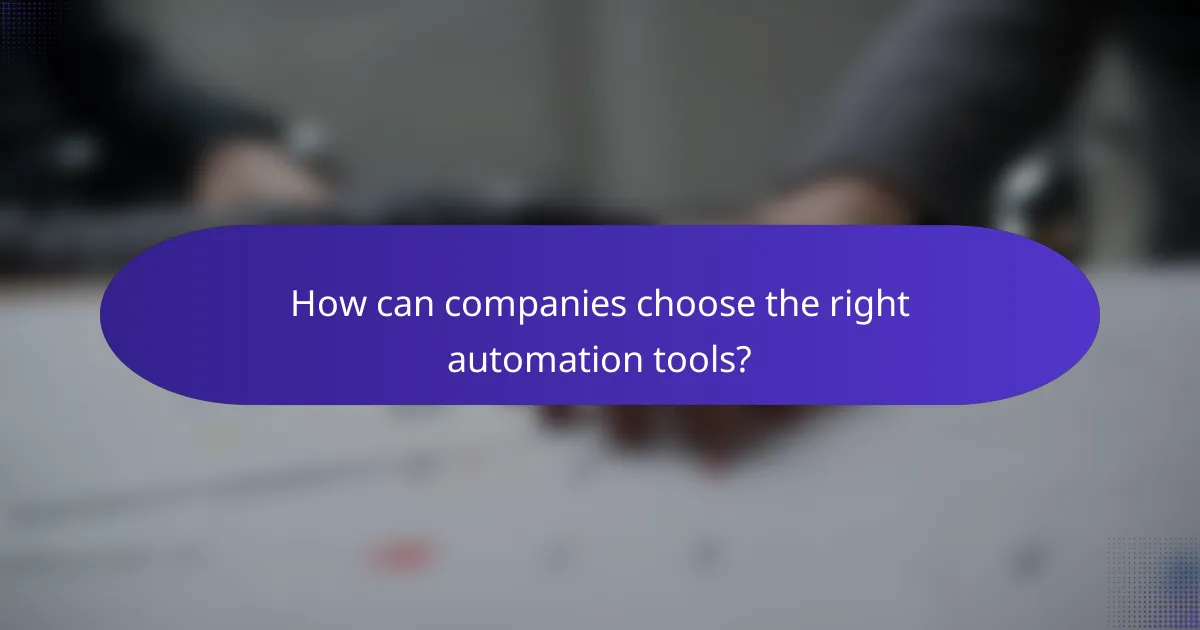
How can companies choose the right automation tools?
Companies can choose the right automation tools by carefully evaluating their specific needs, assessing vendor capabilities, and calculating the potential return on investment. This process ensures that the selected tools align with business objectives and deliver value over time.
Evaluating vendor capabilities
When evaluating vendor capabilities, companies should consider the vendor’s experience, technology stack, and customer support. Look for vendors with a proven track record in the consumer goods sector and those who offer scalable solutions that can grow with your business.
Additionally, assess the integration capabilities of the automation tools with existing systems. A seamless integration can significantly reduce implementation time and costs, enhancing overall efficiency.
Assessing ROI and total cost of ownership
To assess ROI and total cost of ownership, companies should calculate both direct and indirect costs associated with the automation tools. This includes initial purchase costs, ongoing maintenance, and potential savings from increased efficiency.
Consider using a simple ROI formula: (Net Profit from Automation – Cost of Automation) / Cost of Automation. A positive ROI within a reasonable timeframe, such as one to three years, is often a good indicator of a worthwhile investment.
Identifying specific business needs
Identifying specific business needs involves understanding the unique challenges and goals of your organization. Conduct a thorough analysis of current processes to pinpoint areas where automation can provide the most benefit, such as inventory management or customer service.
Engage with stakeholders across departments to gather insights and ensure that the chosen automation tools address the collective needs of the organization. This collaborative approach can lead to more effective solutions and greater buy-in from employees.

What are the future trends in automation for consumer goods?
Future trends in automation for consumer goods are increasingly focused on integrating advanced technologies like machine learning and artificial intelligence. These innovations aim to enhance efficiency, reduce costs, and improve customer experiences across the supply chain.
Increased use of machine learning
Machine learning is becoming a cornerstone of automation in the consumer goods sector, enabling companies to analyze vast amounts of data for better decision-making. By leveraging algorithms, businesses can predict consumer behavior, optimize inventory levels, and enhance product recommendations.
For instance, retailers can use machine learning to analyze purchasing patterns and adjust stock accordingly, reducing waste and improving sales. This technology can also personalize marketing efforts, targeting specific customer segments with tailored promotions, which can lead to higher conversion rates.
To effectively implement machine learning, companies should start with clean and relevant data. Investing in training for staff and ensuring robust data governance practices are essential to avoid common pitfalls such as biased algorithms or data privacy issues. Regularly updating models based on new data will also help maintain accuracy and relevance.
